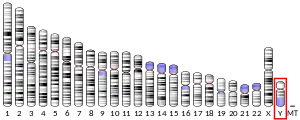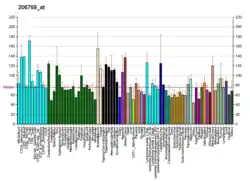| TMSB4Y | |||||||||||||||||||||||||||||||||||||||||||||||||||
|---|---|---|---|---|---|---|---|---|---|---|---|---|---|---|---|---|---|---|---|---|---|---|---|---|---|---|---|---|---|---|---|---|---|---|---|---|---|---|---|---|---|---|---|---|---|---|---|---|---|---|---|
| Identifiers | |||||||||||||||||||||||||||||||||||||||||||||||||||
| Aliases | TMSB4Y, TB4Y, thymosin beta 4, Y-linked, thymosin beta 4 Y-linked | ||||||||||||||||||||||||||||||||||||||||||||||||||
| External IDs | OMIM: 400017 GeneCards: TMSB4Y | ||||||||||||||||||||||||||||||||||||||||||||||||||
| |||||||||||||||||||||||||||||||||||||||||||||||||||
| |||||||||||||||||||||||||||||||||||||||||||||||||||
| |||||||||||||||||||||||||||||||||||||||||||||||||||
| |||||||||||||||||||||||||||||||||||||||||||||||||||
| Wikidata | |||||||||||||||||||||||||||||||||||||||||||||||||||
| |||||||||||||||||||||||||||||||||||||||||||||||||||
Thymosin beta-4, Y-chromosomal is a protein that in humans is encoded by the TMSB4Y gene.[3][4]
The protein consists (in humans) of 44 amino acids (msdkpgmaei ekfdksklkk tetqeknpls sketieqerq ages) MolWt 4881.[5]
Function
This gene lies within the male specific region of chromosome Y. Its homolog on chromosome X (thymosin beta-4) escapes X inactivation and encodes an actin sequestering protein.[4]
References
- 1 2 3 GRCh38: Ensembl release 89: ENSG00000154620 - Ensembl, May 2017
- ↑ "Human PubMed Reference:". National Center for Biotechnology Information, U.S. National Library of Medicine.
- ↑ Lahn BT, Page DC (October 1997). "Functional coherence of the human Y chromosome". Science. 278 (5338): 675–80. Bibcode:1997Sci...278..675L. doi:10.1126/science.278.5338.675. PMID 9381176.
- 1 2 "Entrez Gene: TMSB4Y thymosin, beta 4, Y-linked".
- ↑ "Thymosin beta-4, Y-chromosomal [Homo sapiens] - Protein - NCBI".
Further reading
- Yu FX, Lin SC, Morrison-Bogorad M, Atkinson MA, Yin HL (January 1993). "Thymosin beta 10 and thymosin beta 4 are both actin monomer sequestering proteins". The Journal of Biological Chemistry. 268 (1): 502–9. doi:10.1016/S0021-9258(18)54179-X. PMID 8416954.
- Li X, Zimmerman A, Copeland NG, Gilbert DJ, Jenkins NA, Yin HL (March 1996). "The mouse thymosin beta 4 gene: structure, promoter identification, and chromosome localization". Genomics. 32 (3): 388–94. doi:10.1006/geno.1996.0133. PMID 8838802.
- Sanger Centre, The; Washington University Genome Sequencing Cente, The (November 1998). "Toward a complete human genome sequence". Genome Research. 8 (11): 1097–108. doi:10.1101/gr.8.11.1097. PMID 9847074.
- Skaletsky H, Kuroda-Kawaguchi T, Minx PJ, Cordum HS, Hillier L, Brown LG, Repping S, Pyntikova T, Ali J, Bieri T, Chinwalla A, Delehaunty A, Delehaunty K, Du H, Fewell G, Fulton L, Fulton R, Graves T, Hou SF, Latrielle P, Leonard S, Mardis E, Maupin R, McPherson J, Miner T, Nash W, Nguyen C, Ozersky P, Pepin K, Rock S, Rohlfing T, Scott K, Schultz B, Strong C, Tin-Wollam A, Yang SP, Waterston RH, Wilson RK, Rozen S, Page DC (June 2003). "The male-specific region of the human Y chromosome is a mosaic of discrete sequence classes". Nature. 423 (6942): 825–37. Bibcode:2003Natur.423..825S. doi:10.1038/nature01722. PMID 12815422.
- Torikai H, Akatsuka Y, Miyazaki M, Warren EH, Oba T, Tsujimura K, Motoyoshi K, Morishima Y, Kodera Y, Kuzushima K, Takahashi T (December 2004). "A novel HLA-A*3303-restricted minor histocompatibility antigen encoded by an unconventional open reading frame of human TMSB4Y gene". Journal of Immunology. 173 (11): 7046–54. doi:10.4049/jimmunol.173.11.7046. PMID 15557202.
- Rual JF, Venkatesan K, Hao T, Hirozane-Kishikawa T, Dricot A, Li N, Berriz GF, Gibbons FD, Dreze M, Ayivi-Guedehoussou N, Klitgord N, Simon C, Boxem M, Milstein S, Rosenberg J, Goldberg DS, Zhang LV, Wong SL, Franklin G, Li S, Albala JS, Lim J, Fraughton C, Llamosas E, Cevik S, Bex C, Lamesch P, Sikorski RS, Vandenhaute J, Zoghbi HY, Smolyar A, Bosak S, Sequerra R, Doucette-Stamm L, Cusick ME, Hill DE, Roth FP, Vidal M (October 2005). "Towards a proteome-scale map of the human protein-protein interaction network". Nature. 437 (7062): 1173–8. Bibcode:2005Natur.437.1173R. doi:10.1038/nature04209. PMID 16189514. S2CID 4427026.
This article is issued from Wikipedia. The text is licensed under Creative Commons - Attribution - Sharealike. Additional terms may apply for the media files.


